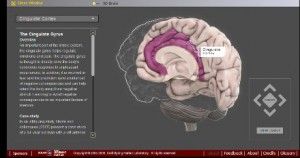Whatever you’re doing now, stop. Click here. Spend the remainder of your evening exploring the remarkable features found on Cold Spring Harbor’s Genes to Cognition Online:
- The 3-D interactive, rotating brain is a must-see for neuroscience faculty. I plan to use this in class to demonstrate neuroanatomy.
- Animations include reading facial expression, memory formation at the synapse, and how to knockout genes in mice.
- Interactive experiments give students access to real experimental data.

The 3-D Interactive Rotating Brain Is a Terrific Teaching Tool
The G2C Online advisory panel included Robert Ballard (Clemson University), Seth Grant (Sanger Institute), Joe Novak (IHMC), Robert Plomin (SGDPC), Kay Redfield Jamison (Johns Hopkins University), Ed Rover (Dana Foundation), and Tim Tully (Helicon Therapeutics).
Many thanks to the Dana Foundation and the William and Flora Hewlett Foundation for making this resource available.


2 Comments
Stephmena · November 24, 2009 at 5:12 pm
I just went on to the website and it is soo cool. It gives images of the brain and its different parts. It is definitely one of thos websites that you could spend for ever on check out the brain and the genetics of people. I thought that the 3- D brain was the best part of the website. You select the part of the brain that you want to see and it brings it up along with a description. The internet is definitely helping with the study of the brain.
Laura’s Psychology Blog » Genes to Cognition 3-D Brain App · April 21, 2010 at 4:48 pm
[…] I mentioned in a previous post, Cold Spring Harbor has done an absolutely fantastic job on the Genes to Cognition site, which was launched just about one year ago. Just be sure to wait to visit until you’ve […]
Comments are closed.